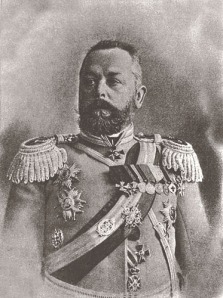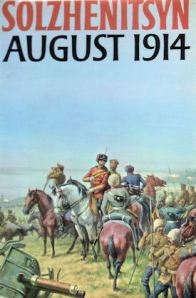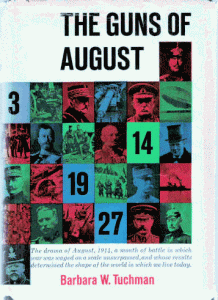“His sense of ease grew and grew. He had lived out a long life of army service in which danger and the risk of death were inevitable; now that he had reached the moment of death and was ready for it, he realized as never before how easy, how much of a relief it would be. The only problem was suicide was counted a sin…He began now with the set prayers, then none at all: he simply knelt, breathing and looking up into the sky. Then casting aside restraint, he groaned aloud, like any dying creature of the forest: ‘O Lord, if Thou canst, forgive me and receive me. Thou seest – I could do no other, and can do no other now.” – Aleksandr Solzhenitsyn, August 1914
All the night of the 29th-3Oth they stumbled through the woods that fringe the north of the railway from Neidenburg to Willenberg, moving hand in hand to avoid losing one another in the darkness. Samsonov said repeatedly that the disgrace of such a defeat was more than he could bear. “The Emperor trusted me. How can I face him after such a disaster?” He went aside and his staff heard a shot. They searched for his body without success, but all are convinced that he shot himself. – Sir Alfred Knox, With the Russian Army: 1914 – 1917
Riding through the woods that fringed the railroad, he and his companions reached Willenberg, only seven miles from the Russian frontier, but the Germans had arrived there before them. The General and his group waited in the forest until before nightfall and then, as it was impossible to proceed over the swampy ground in the dark on horseback, continued on foot. Matches gave out and they could no longer read their compass. Moving hand in hand to avoid losing each other in the dark, they stumbled on. Samsonov, who suffered from asthma, was visibly weakening. He kept repeating to Potovsky, his chief of staff: “The Czar trusted me. How can I face him after such a disaster?” After covering six miles, they stopped for a rest. It was then 1:00 a.m. Samsonov moved apart into the thicker darkness under the pines. A shot cracked the stillness of the night. Potovsky knew exactly what it meant. Earlier Samsonov had confided his intention of committing suicide, but Potovsky though had argued him out of it. He was now sure the General was dead.” – Barbara Tuchman, The Guns of August
The three excerpts given above are separate accounts of the same event: the suicide of Russian general Aleksandr Samsonov in the immediate aftermath of the destruction of the Russian Second Army which he commanded at the Battle of Tannenberg. The battle was the first major clash on the Eastern Front during World War I. In the space of just five days, Samsonov’s army lost 140,000 killed, wounded or taken prisoner. Of his original force, a mere 10,000 escaped. Samsonov was also killed, not by an enemy bullet, but by his own hand. The difference between the excerpts offers a concise study of how history is shaped and interpreted.
History Being Made & History Being Made Up
The first of the three excerpts, comes from one of the least known works of famed Russian writer Aleksandr Solzhenitsyn, his novel August 1914. It is a fictionalized account in which Solzhenitsyn took creative liberties with what he had read about the suicide. One of Solzhenitsyn’s main sources was Sir Alfred Knox’s With the Russian Army 1914 – 1917 who provides the second excerpt. Knox actually appears as a character in Solzhenitsyn’s novel. That being said, there is a vast difference between the two. Knox’s account is seemingly factual, while Solzhenitsyn’s is very loosely connected to the facts. This is the difference between how history is made (or written) and how it is made up.
That is not to suggest there is anything wrong with what Solzhenitsyn has done. If anything, his psychoanalytical approach gives the reader a window into the mindset of Samsonov in the moments just before he committed the ultimate act. Even for those who last saw Samsonov, they could not possibly know exactly what was going through his mind while under such shocking distress. It is rather obvious from what transpired that Samsonov was deeply disturbed and not thinking straight in the wake of the battle. He must have felt that his life’s work as a soldier and leader had all been a terrible failure. There was only one way out for this career soldier – by taking a bullet. In Solzhenitsyn’s retelling, death was the best option left to Samsonov. The key words in the excerpt are: “how much of a relief it would be.” Death offered not only an escape, but also redemption. It was the only thing left that could alleviate his suffering.
After Such a Disaster – Tragic Loyalty
Knox’s account is the most reputable English language source on the event. At a glance, it comes across as a first-hand observation and is seemingly factual. It is actually based on what Knox heard, not what he exeprienced. He was not actually there. He had heard from people who had intimate knowledge (or said they did) of what occurred. From Knox, we get an idea of the chaotic effort to escape by Samsonov and his staff. Crucially from a purely historical standpoint, he gives us the telling quote “The Emperor trusted me. How can I face him after such a disaster?” Those words followed Samsonov to the grave and would provide the most intimate part of the incident. The way in which Samsonov is viewed historically has much to do with this quote. It shows him as a tragic, loyal figure rather than an inept and overwhelmed commander. Which was he? Most likely a little bit of both. He was in over his head, probably should have never been appointed to such a high command and though loyal, had little idea of how to lead an army. In sum, Knox presents us with a confused and lost man, whose shame will not allow him to face the light of another day.

Sir Alfred Knox – gained first hand experience with the Russian Army and a second hand account of General Samsonov’s suicide
Swallowed By Darkness – The Moment & the Man
The final excerpt is from perhaps the most famous work on the beginning of World War One, Barbara Tuchman’s The Guns of August. Tuchman’s book deals very little with events on the Eastern Front, but it does cover the Battle of Tannenberg. She does a fabulous job of setting the scene for Samsonov’s final act. Whereas Solzhenitsyn is concerned with the psyche of Samsonov, Tuchman sets up the suicide with a foreboding description of the natural surroundings which the ill-fated Samsonov and his staff find themselves lost within. A cloistered world of darkness and nightfall, covered with woods, swampy ground and pines. It is a world that closes in on Samsonov. He ends up both literally and figuratively swallowed by the darkness.
Each of the excerpts lends a different perspective to the suicide of General Aleksandr Samsonov. Solzhenitsyn is psychoanalytical and spiritual. Knox is tragically descriptive. Tuchman’s piece is filled with a deep and ambient darkness. From these unique passages we have the same event cast in radically different forms. Through these writings we see history being created, molded and reimagined. Solzhenitsyn, Knox and Tuchman may have been distant in space and time from Samsonov, but through their writing they managed to resurrect both the moment and the man.



